Type 2 connector
The IEC 62196 Type 2 connector (commonly referred to as mennekes) is used for charging electric cars within Europe. The connector is circular in shape, with a flattened top edge and originally specified for charging battery electric vehicles at 3–50 kilowatts, with a plug modified by Tesla capable of outputting 150 kilowatts. Electric power is provided as single-phase or three-phase alternating current (AC), or direct current (DC). In January 2013, the IEC 62196 Type 2 connector was selected by the European Commission as official charging plug within the European Union.[1] It has since been adopted as the recommended connector in some countries outside of Europe, including New Zealand.[2]
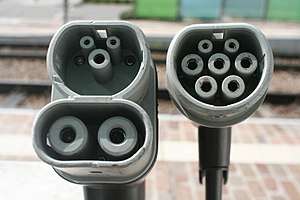 Comparison between extended Combo2 - DC Charger (left) and normal Type 2 - 1‒3 phase AC Charger (right). | |||
| Type | Electric vehicle charging | ||
|---|---|---|---|
| Production history | |||
| Designer | Mennekes | ||
| Designed | 2009 | ||
| Produced | 2013 | ||
| General specifications | |||
| Length | 200 millimetres (7.9 in) | ||
| Diameter | 70 millimetres (2.8 in) | ||
| Width | 70 millimetres (2.8 in) | ||
| Height | 63 millimetres (2.5 in) | ||
| Pins | 7 (1 earth, 3 positive, 1 negative, 2 signalling) | ||
| Connector | VDE-AR-E 2623-2-2 | ||
| Electrical | |||
| Signal | DC, 1‒3 phase AC | ||
| Earth | Dedicated pin | ||
| Max. voltage | 480 V | ||
| Max. current | 300 A | ||
| Data | |||
| Data signal | SAE J1772#Signaling: Resistive / Pulse-width modulation | ||
| Pin out | |||
| Pinouts for Type 2 male and female electric vehicle charging plugs | |||
| PP | Proximity pilot | pre-insertion signalling | |
| CP | Control pilot | post-insertion signalling | |
| PE | Protective earth | full-current protective earthing system—6-millimetre (0.24 in) diameter | |
| N | Neutral | single-/three-phase AC / DC-mid | |
| L1 | Line 1 | single-/three-phase AC / DC-mid | |
| L2 | Line 2 | three-phase AC / DC-mid | |
| L3 | Line 3 | three-phase AC / DC-mid | |
| Combo 2 extension adds two extra high-current DC pins underneath, does not use the AC pins and is becoming the universal standard for charging. | |||
Released under the name SAE J3068 is three-phase AC connector for North America—with Local Interconnect Network (LIN) for control signaling based on IEC 61851-1 Edition 3 Annex D.[3][4]
The Guobiao standard GB/T 20234.2-2015 for AC-charging within the People's Republic of China specifies cables with Type 2-style male connectors on both ends, and a female inlet on vehicles[5]—the opposite gender to the rest of the world, and with different control signalling.
Description
Cars are fitted with a standardised male vehicle inlet, whilst charging station are fitted with a female outlet, either directly on the outside of the charging station, or via a flexible cable with permanently attached connector on the end. A charging station with a permanently fixed cable can be attached directly into the vehicle inlet, similar to using a petrol pump and when no fixed cable is available, a separate male-to-female cable is used to hook up the vehicle either using the charging station, or from a traditional IEC 60309-2 industrial connector.
The Type 2 connector system was originally proposed by Mennekes in 2009 leading to the colloquial name of Mennekes. The system was later tested and standardised by the German Association of the Automotive Industry (VDA) as VDE-AR-E 2623-2-2, and subsequently recommended by the European Automobile Manufacturers Association (ACEA) in 2011. As of 2015, Type 2 is intended to replace the previous vehicle connectors used for AC charging within the European electric vehicle network, displacing both SAE J1772 and EV Plug Alliance Types 3A and 3C. For DC charging, the Combo 2 socket (Type 2 supplemented with 2 DC pins) shall become standard in cars, replacing Type 4 CHAdeMO. The transition period is scheduled to last until 2020.[6]
The IEC 62196 Type 2 connector is used in a slightly modified form at all European Tesla Model S and Model X vehicles, and the European Tesla Supercharger network.[7] As of 2017 Tesla is the only automaker which offers based on the IEC 62196-2 specification the charging with alternating current and direct current. For charging with direct current the specification IEC 62196-3 Combined Charging System (CCS) is favored in Europe.[8]
Pins
The connectors contain seven contact places: two small and five larger. The top row consists of two small contacts for signalling, the middle row contains three pins, the centre pin is used for Earthing, while the outer two pins used for the power supply, optionally in conjunction with the two pins on the bottom row which are also for power supply. Three pins are always used for the same purposes:
- Proximity pilot (PP): pre-insertion signalling
- Control pilot (CP): post-insertion signalling
- Protective earth (PE): full-current protective earthing system—6-millimetre (0.24 in) diameter[9]
The allocation of the four normal power supply pins vary depending on the mode of operation. They are allocated as one of:
- Neutral (N) and line (L1): single-phase AC
- Neutral (N) and line phases (L1, L2, and L3): three-phase AC
- Neutral (N) and line (L1); negative (−), and positive (+): combined single-phase AC and low-current DC
- Negative (−) and positive (+): low-current DC
- Negative (−, −) and positive (+, +): mid-current DC
Communication takes place over the signalling pins between the charger, cable, and vehicle to ensure that the highest common denominator of voltage and current is selected.
DC charging
Some vehicle inlets may contain the extra connections to allow the Combo Coupler DC-only charger to be inserted.[10]
Gallery
 Type 2-compatible socket outlet found on Tesla Superchargers in Europe
Type 2-compatible socket outlet found on Tesla Superchargers in Europe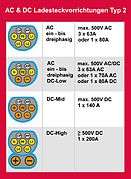 Various Type 2 plug operating modes
Various Type 2 plug operating modes Type 2 vehicle inlet for electric charging (male)
Type 2 vehicle inlet for electric charging (male)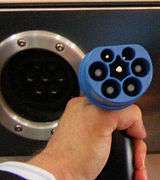 Charging station socket outlet (female) and matching plug (male, blue color). In PRC (only), a male is used for both ends of cables.
Charging station socket outlet (female) and matching plug (male, blue color). In PRC (only), a male is used for both ends of cables.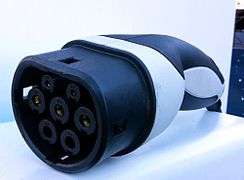 Type 2 connector (female Mennekes)
Type 2 connector (female Mennekes)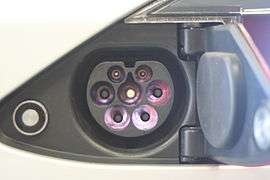 Type 2-compatible 120 kW inlet on European Tesla Model S
Type 2-compatible 120 kW inlet on European Tesla Model S
References
- "Type 2 charging plug proposed as the common standard for Europe". MENNEKES. 2013-01-30. Retrieved 2017-03-25.
- "Charging point connectors and socket outlets". NZ Transport Agency. Retrieved 2019-02-15.
- "Developing Infrastructure to Charge Plug-In Electric Vehicles". Alternative Fuels Data Center. Retrieved 7 November 2017.
Future AC Charging Options … An additional standard (SAE J3068) is under development for higher rates of AC charging using three-phase power, … adapted from the European three-phase charging standards and specified for North American AC grid voltages and requirements.
- McLaughlin, Jim (23 October 2017). SAE J3068TM 3-phase AC charging update (PDF). EPRI Truck and Bus meeting (Report). Retrieved 13 December 2017.
J3068 adopts the European Type 2 coupler, 5 wire with neutral and adds a simple, robust, inexpensive and established datalink: LIN pulse width is the same as 5% PWM, so filters do not change.
- 电动汽车传导充电用连接装置 第 2 部分:交流充电接口 [Connection set for conductive charging of electric vehicles—Part 2: AC charging coupler] (unofficial English translation offered by EuropElectro) (Report). 22 December 2011. pp. 1–24. Retrieved 13 December 2017.
- "EU launches clean fuel strategy". European Commission. 2013-01-24. Retrieved 2017-03-26.
- "REVIEW: Type 2 Charging Cable with Built-in Chargeport Opener". TESLARATI. 2015-06-05. Retrieved 2017-03-21.
- "Charging infrastructure". DIN e. V. Retrieved 2017-03-21.
- Oestreicher, Ralf; Daimler (30 July 2010). "AC/DC vehicle inlet options: As proposed by German Initiative Charging Interface" (presentation slide image). Plug-in 2010. Retrieved 7 April 2016.
Reuse of 6mm earth pin of AC connector allows non isolated DC charging or use of one isolation transformer for several vehicles at up to 250A DC
- European Automobile Manufacturers Association (2 March 2011). "ACEA position and recommendations for the standardization of the charging of electrically chargeable vehicles". Brussels. Retrieved 14 June 2014.